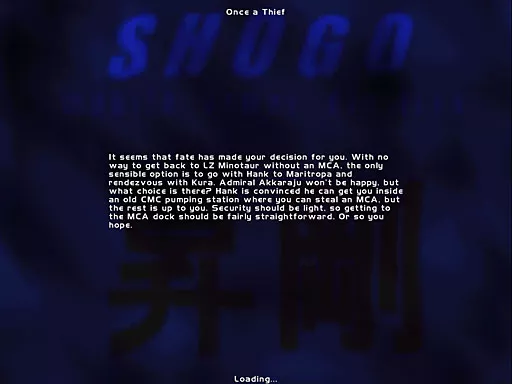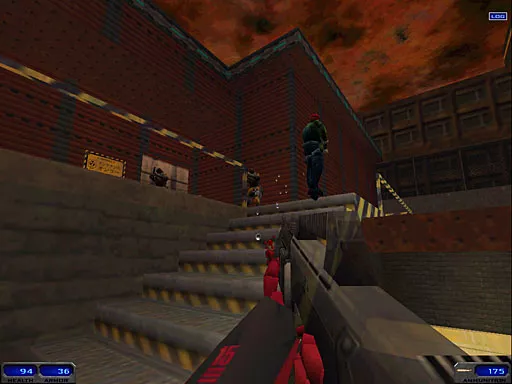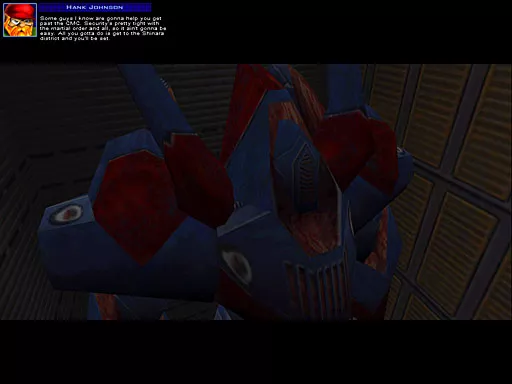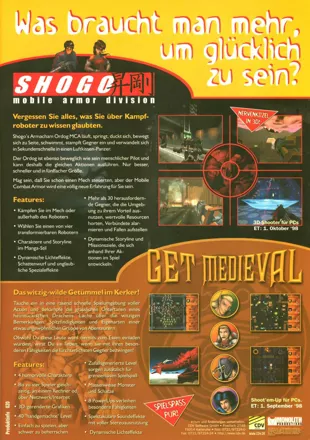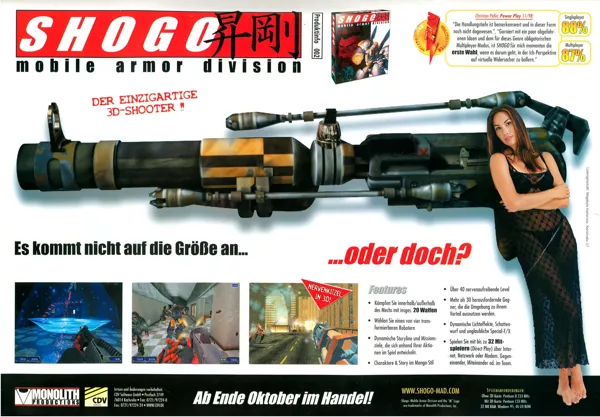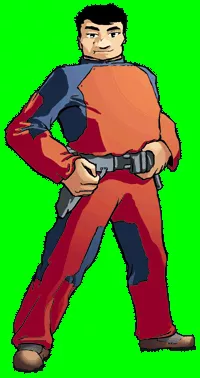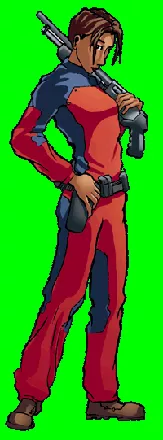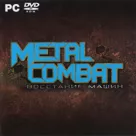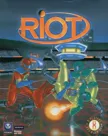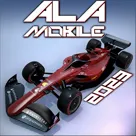Shogo: Mobile Armor Division
Description official descriptions
Sanjuro is a commander in the army of United Corporate Authority and a pilot of a Mobile Combat Armor (a giant mech) in the far future. The UCA is fighting the Fallen, a terrorist organization. This conflict has its victims: Sanjuro's brother, best friend and girlfriend all died while completing a mission years ago, and only recently he has been somewhat succeeding in putting the past behind him. Now Sanjuro is given a mission to find and kill Gabriel, a new leader of the Fallen. But during this assignment, ghosts of the past will come back to haunt him.
Shogo: Mobile Armor Division is a first-person shooter that incorporates ideas from anime and the MechWarrior series. On some levels, the player controls Sanjuro while he is on foot, infiltrating enemy buildings and fighting with handheld firearms. Sanjuro can find health power-ups, more powerful weapons and ammo. Both Sanjuro and the enemies will randomly score critical his, which not only cause more damage, but also replenish a small portion of health.
On other levels, the player pilots one of the four available MCAs, which differ a little in characteristics. This giant mech can walk, jump and crouch just like a human being, and controlling it is very similar to controlling Sanjuro. The player guides this colossus through city districts swarming with enemy soldiers and mechs. It is also possible to transform the mech into a vehicle, though it can not defend itself in that state.
The story progression is linear for the most part. However, at one point, the player is prompted to make a choice that will affect the rest of the plot and the ending.
Spellings
- Ярость. Восстание на Кронусе - Russian spelling
Groups +
Screenshots
Promos
Videos
See any errors or missing info for this game?
You can submit a correction, contribute trivia, add to a game group, add a related site or alternate title.
Credits (Windows version)
74 People · View all
| Game Designer and Lead Level Designer | |
| Lead Game Engineer | |
| Lead LithTech Engineer | |
| LithTech Sound System and Tools Engineer | |
| Lead Texture Artist and Designer | |
| Level and Game Designer | |
| Lead 3D Animator | |
| Game Engineer | |
| Producer | |
| Level Designer | |
| Mecha Designer and Texture Artist | |
| LithTech Engineer | |
| Texture Artist |
|
| Lead Audio Designer | |
| Weapon and Character Designs by | |
| Audio Composer | |
| Audio Technician | |
| Additional LithTech and Shogo Engineering by | |
| Additional 3D Animation | |
| [ full credits ] | |
Reviews
Critics
Average score: 82% (based on 36 ratings)
Players
Average score: 3.8 out of 5 (based on 72 ratings with 5 reviews)
Sometimes it clicks and sometimes it clunks
The Good
If nothing else, Shogo: MAD is a stylish game. Although Monolith Productions is an American developer they've done their research and perfectly captured the zany art style of animes like BattleTech and Gundam Wing. With a wildly unusual premise and huge production values, this was Monolith's big offering for 1998.
Shogo features standard, on-foot FPS action and combat with anime-style battle mechas. The on-foot parts of the game are fairly standard FPS fare. You play as Sanjuro Makabe, a soldier who has recently lost his girlfriend in a tragic accident. He's been summoned to the moon Cronos, where an element has been discovered that enables space-craft to travel at faster-than-light speeds. This immensely valuable resource has led to all of Earth's nations to scramble for control of Cronos, and you've got to help oust a rebel leader who has seized control. Predictably, the story rapidly disintegrates into a mess of lies, betrayals and back-stabbings that Shakespeare would be proud of.
But it isn't enough to go pedestrian these days, and you've got a choice of four gigantic mecha robots that eat tanks for breakfast. This is the game's main selling point and is a clothesline for all kinds of wacky stuff. You can jump on top of skyscrapers and get along building-tops, or kick cars around and step on human beings like insects. You get a whole bunch of devastatingly powerful weapons (the 4x rocket-launching Bullgut being my favourite) and can pick and choose the mecha you control for even greater variety (for example, the Andra 35 Predator is slow but powerful, while the Shogo Akuma Series 12 is faster and weaker).
You can't switch from on-foot to in-mecha any time you want, but only when the game lets you. Some levels you'll play as a mecha, others will be fought entirely on foot. Both modes get very repetitive on their own but the levels are split up so you're never doing one or the other for too long.
Like Quake 2 and Half-Life, the game is mission driven, and you usually have to complete a series of objectives to win a level. At two pivotal points in the game, the player also has the opportunity to make a crucial decision which can alter the game's ending. While the first decision is almost purely a narrative decision, the second decision actually determines who you'll be facing the rest of the game and how the game will end. If nothing else, the ability to play the game twice with two different sets of final missions adds to the game's replay value.
There's a lot of smart concepts floating around here. You have dynamic audio (when fighting a battle the music picks up tempo, for example), and the most accurate polygon hit-boxing yet seen in a shooter. How much damage you inflict on an enemy depends on where you shoot them, making the game a lot more tense and realistic. Especially since it's a two-way street and you run the risk of an enemy taking you out with a single shot to the head.
One cool feature in this game that really sets it apart from the pack is the Critical Hit system. If you hit someone in a certain part of the body (it varies) or just particularly hard, they flash purple and you gain health, giving you not only an incentive to kill your enemies, but kill them with style. I'm not sure what the explanation for this is, but it's a really good idea and means you can easily replenish your health even when there are no health packs around.
And of course it's all powered by Monolith's first-generation LithTech engine, and while it's rather buggy and unstable it allows for truly spectacular visuals, easily surpassing Quake 2 and Unreal. Explosions and light effects are rendered in glorious detail, and although the polygon models are rather blocky (the anime art style is an angular one, anyway) Shogo makes up for this with intricate character motions and gestures comparable to the first Resident Evil game. As soon as you see a character shrugging or cracking his knuckles you'll know what I mean.
The Bad
The previous reviewers have said it well. Shogo: MAD was designed by people who had a lot of bright ideas but no clue how to put them together into a game. Some parts really impressed me, but for everything Shogo: MAD does well, it does something else poorly. It's a clumsy, hit-and-miss game only a fanboy could truly love.
The meat of the game (mecha combat) simply doesn't work. When you're riding around in a 30-foot robot there has to be a sense of wonder and amazement, and the game fails to communicate this to the player. It doesn't feel like you're stomping around in a giant metal suit weighing hundreds of tons. It feels like you're a gravity-defying ballerina. You can jump to ridiculous heights, do impossible mid-air pirouettes...heck, the game doesn't even attempt at making the physics feel right. Aside from realism there isn't much real difference from being on the ground to being in a mecha. The controls are the same as in human form, your abilities are the same as in human form, the weapons function like souped-up versions of whatever you were using on the ground...why bother?
Mecha combat is almost laughably easy due to your overpowered weapons and the enemies' buggy AI. Some of these bugs are so severe they almost break the game. For example, when an enemy mecha gets hit it goes through a lengthy recoil animation (sometimes as long as 2-3 seconds) and you'll almost certainly be able to fire again before it's ready, effectively paralysing it until it's destroyed. By exploiting AI loopholes like this you can cruise through most mecha levels with impunity, and only when you have to face multiple mecha does the going get tough. The mecha levels are very straightforward and boring, usually just finding a building or flipping a switch somewhere. Come on guys, this is a game about giant robots. Surely there must be more exciting gameplay possibilities then that.
Since the mecha side of the game is a substantial disappointment, are the game's on-foot portions good enough to redeem the game? I won't deny it, Shogo: MAD provides a nice slab of classic FPS action and this is probably the game's most successful aspect. But even here there are many glaring problems. The game restricts itself to indoor levels, once the badass anime theme gets old the game becomes an exercise in repetition, with whole levels consisting of gigantic mazes and nearly identical hallways filled with enemies. Speaking of which, the enemies are texture-swapped versions of the same few models, and this gives the feeling you're fighting an army of clones.
I could point out that Shogo contains some squad-based elements that add a bit of interest to the gameplay, but sadly these are mere gimmicks that never rise above the level of baby-sitting missions. You either have to help a group of friendly soldiers in a firefight (which you could probably win on your own, by the way) or help a scientist into a compound so he can deactivate a computer or something retarded. At least your "squad mates" have decent AI and can be trusted not to get stuck against walls, so that's something to be thankful of.
In contrast to the somnolent mecha gameplay, Shogo's ground-based missions are extremely hard. Even on the lower difficulty levels you'll soon be best friends with the quick-load key. On the higher difficulty levels prepare to leave your ego at the door, as your enemies have superhuman reflexes and will open fire on you as soon as you walk into their view, leading to instant death if you're not ready. Add to this the high damage levels they can dish out (Shogo: MAD isn't quite a "two hits and you're dead" tactical shooter, but it gets pretty close some times) and you've got a game that often leans towards frustrating.
Level design (in a typical Monolith way) starts out strong but gets steadily worse as the game progresses. To any amateur modders out there, take note of Shogo: MAD's final missions because they are textbook examples of how levels should not be built. They're just a long series of identical hallways to get lost in, peppered with randomly-placed enemies that bog gameplay down to a slog. And architecture doesn't vary much so if you find a place you'll need to come back to (such as a locked door) you'll have one hell of a job finding it again. Admittedly most of the levels are less boring than the example above (one particularly fun level has you zipping through air shafts reminiscent of Quake) but there's still a gratuitous over-use of mazes and other stock FPS devices to complicate and extend play life.
The "story" is a huge load of crap, and is basically just a generic gotta-save-the-world plot but made more complicated through a million unnecessary subplots (female love interests, the rejection of your best friend, ...) which have el zilcho to do with the game itself and all miraculously resolve themselves when you beat the final boss. What's a inane soap opera to begin with is made even worse through pandering to the sensibilities of a PG-rated thriller movie. Let me give you an example: you have to infiltrate an enemy base, but a gate that you need a key to unlock blocks your path. The key is held by an elderly woman (you can see where this is going already, can't you?) who has lost her pet cat, and you'll have to find it for her before she'll give you the key. This development stopped me dead in my tracks, unable to believe what I'd just been told. Excuse me? The whole world hangs in the balance and I'm expected to find a lost pet to continue the game? I've watched Disney cartoons that are less condescending.
Plus it was released just two weeks before a certain game that stole all the holiday season hype, and that hardly helped.
The Bottom Line
I pity an FPS game trying to compete with Half Life's massive success; it must have been like an American musician trying to keep his career afloat during the British Invasion. Although personally I'd attribute Shogo: MAD's lack of success to an entirely different reason: it's a mediocre game.
It has lots of promise and with a bit more time in development (someone correct me but wasn't Monolith designing and marketing Blood 2 more or less simultaneously?) it could have been a classic. But Shogo is a half-baked mess and even an anime nerd would have a hard time digesting it. Get No-One Lives Forever.
Windows · by Maw (832) · 2007
Has lots of cool things but Monolith just couldn't put it all together.
The Good
Plenty of good, pulse-pounding action comes packed in Shogo, an fps that gives you the chance to fight enemies both on foot or aboard a gigantic mecha and rain hell over cities and military complex... cool innit?
The game is a standard plot-driven fps game, even if it plays by missions. You have your share of scripted sequences as well as other plot-enhancing features like different plot threads (which can lead you to two very different game endings as well as different missions) and other gimmicks.
As I mentioned before, the action takes center stage in this game, so you can expect fast and furious fps fights courtesy of the Lithtech engine. The engine may not be the flashiest thing out there (especially in this early incarnation of it) but it does deliver fluid animation and fast graphics with lots of explosions and lightning effects. An interesting feat included in the engine is the real-time hit area detection which means that enemies react accordingly to your hits depending on where do you hit them just like in Blood 2. Though this may spell interesting strategic possibilities the fact is that it's just an aesthetic touch, and there's absolutely nothing wrong with that! You can juggle your opponents in the air with multiple hits, or get quick laughs as you hit them in the knees and watch them do the famed "machine gun cha-cha". That coupled with the amount of enemies and gang-bang type of firefights gets you a fantastically hyperkinetic experience that goes hand in hand with Shogo's outlandish animé world.
Of course, when you take the seat of one of the 3 mechas, the game takes a slightly different edge and you play in a much more over-the top enviroment where you can make gigantic jumps, wield absolutely devastating weapons that can level entire cities, and generally raise some major hell in the name of virtual entertainment. Yay! The mecha-segments are also the ones that feature some of the best level designs in the game, a great level has you jumping from skyscraper to skyscraper while shooting down enemy mechas as you try to get to the other side of the city, and an easy but dramatic fight takes place on the main building in an eery construction yard... very nice, quite a refreshment from the standard fps sequences of "fetch key, go kill gonzo, repeat".
The animé angle is pretty amusing when coupled to an fps game, and it's well implemented too since obviously the developers knew what makes the genre tick and capitalized on most of it's common points. The background storyline deals with some typical war among some military factions in the future, but as in most good animés this is just a backdrop for the personal struggles of the main characters, their sappy melodramas, their feelings of guilt, teen angst, etc. etc. I know I make it sound like crap, but it's a great capture of the "generic animé spirit" if that spirit is crap well, that's another issue...
The Bad
The game is just a mess. Save for the few points I mentioned up there the whole thing just seems hastily stitched together. It's not that bad really, but I get the feeling the guys at Monolith realized that an animé-based game fps would be a cool idea so they bothered to research all the art, licensed the world's crappiest J-pop song (as per standard animé requirements) and wrote a typically entertaining melodrama-in-war story that fitted the genre, but didn't actually put that much thinking in the general construction of the game. The levels themselves hardly ever make sense from a gameflow perspective, and they fall to some of the worst cliches ever in the genre (the last level if you choose to go against your superiors is a throwback to fps hell for instance). The mission design is often inconsistent and just boils down to "shoot the hell out of everything" and the AI is terribly predictable and stupid (especially that of the "bosses").
To further prove that the developers spent all the time thinking of cool things to jam in their game and not how the game used them you have a collection of genuinely good concepts that are blatantly wasted for no reason! ie: you have some stealthy weapons, but the game always forces you into head-on confrontations, so what is the use for them? When piloting mechas you can transform them into some weird-ass vehicles that only make you move slightly faster, but since you lose control of your weapons and there are no situations that call for you to "run to x place" or "escape x thing" what's the use?? Want more? By the 3rd/4th mission you'll already have the full, yes FULL, arsenal for your mecha!! (well, except for that Red Riot thingie that you get at the end)... what's the point of being able to choose from eight or so super kickass weapons if they all just fall on your ass from the get-go? This may sound stupid, but remember how gaining each weapon was a dramatic and super thrilling moment in games like Half-Life or Doom?? And each one was instantly cleverly introduced to you so that you could carefully experiment and find out their pros and cons? Well, Shogo just throws the whole arsenal at you! Have fun! You just start choosing the ones that seem more powerful and work your way downwards! Geez... and the worst part is that the mecha weapons are incredibly cool! And speaking of Mechas, why didn't they introduce at least some differences in gameplay or interface? Would it have killed them to provide a HUD or something to remind you that you are actually in an armored behemoth and not just playing the same fps game only in gigantor-mode and with different textures? Man, what a waste....
Oh, and lest I forget: This early versions of the LithTech engine had some major issues with some 3D cards. I hardly think they are a problem nowadays, but they were one to me in it's time, with dissapearing walls, textures, critters, etc... Don't say I didn't warn you!
The Bottom Line
Shogo has a lot of cool elements and creative juice, but it doesn't seem to pull it down into the reality of it's own game. The game just feels like a loose collection of ideas and concepts, whenever they do merge together you get a glimpse of Shogo's potential, specially with it's fierce and intense firefights and Mecha action. But for the most part it's just an averagely entertaining game that's hard to recommend in the face of all the other superior games out there.
And that song... THAT HELLISH SONNGGAAARARHRHH!!!!!!!
Windows · by Zovni (10504) · 2003
More Shooter like than Mech Sim, Great game!
The Good
The game's most impressive feature is its anime style.From its Japanese rock music intro, to its humoristic ending anime is everywhere. All characters in the game are drawn in an anime fashion, the robots when they move have the foot stomp sound. When characters notice you there is that sun clang ever prevalent in anime. The Mech designs are top notch, enemies and good guys look great. The good guys get to choose 3 types of Mech, and if you don't like the one you have, you can change it during certain points in the game. The Mech weapons are the ones that really shine. The Mech weapons includes Pulse Cannons, Sniper Rifles, Lasers, and this Nuke weapon called the 'Red Riot'. Lastly, it is extremely fun to go around in the Mech stomping on infantry, and destroying billboards and automobiles. The human weapons also have cool reload and pull out animations and sounds. Oh ya, the game is also filled with sarcastic dialogue by the protagonist, and one character is for purely comedic purposes.
The Bad
There is nothing I really didn't like about the game. I think the story was to cliche. Of course it is the typical family vs. duty type storyline where the main character has a brother and a girlfriend lost in battle. Also, you know to soon of who the main bad guy is, and who is everyone else. The scripting deals mostly with go to one location and someone or something talks. There is no terrain deformation like in Half-life. Lastly, while I said the Mech weapons are impressive, the human weapons are pretty typical.
The Bottom Line
The game is basically an FPS. The Mech part is no Mechwarrior combat, it sticks more to FPS. The game is pretty easy for most shooter fans, and has the anime feel.
Windows · by Mister_T (15) · 2000
Discussion
| Subject | By | Date |
|---|---|---|
| Review of Shogo: Mobile Armored Division | Eric Brewster | Mar 2, 2012 |
Trivia
If you keep scrolling past the credits you'll find some interesting messages. Some are just plain dumb (Shogo rulz, monolith rulz, etc...) but some, like the ones that tell of all the different names the game had (heavy metal, Metal Tek, Riot, etc.) are quite funny to read.
Analytics
Upgrade to MobyPro to view research rankings!
Related Sites +
-
Planet Shogo
fan-site with everything from game info to cheats, editing and mods (archived - 2005)
Identifiers +
Contribute
Are you familiar with this game? Help document and preserve this entry in video game history! If your contribution is approved, you will earn points and be credited as a contributor.
Contributors to this Entry
Game added by Derrick 'Knight' Steele.
Linux added by chirinea. Amiga added by Kabushi. Macintosh added by Martin Smith.
Additional contributors: Zovni, Apogee IV, tarmo888, Ivan Napreenko, Stratege.
Game added March 26, 2000. Last modified February 13, 2024.


